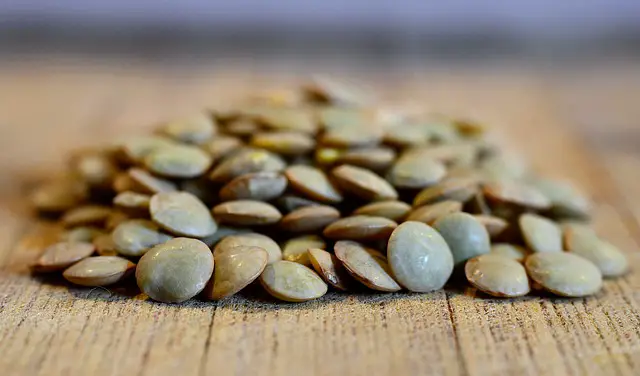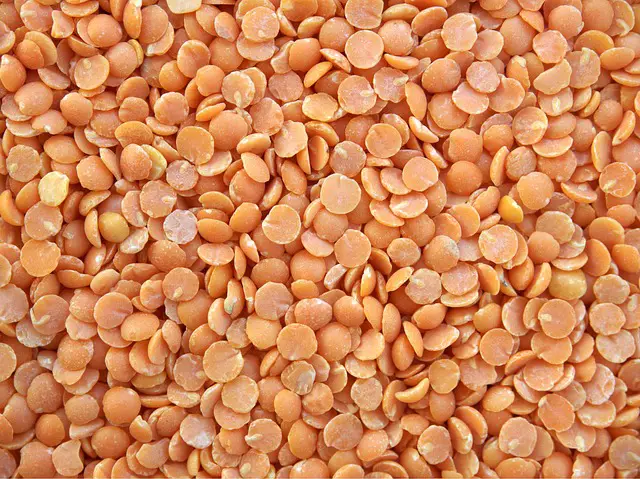Green lentils are firmer, have a nuttier flavor, take longer to cook but hold their shape better. They’re great for salads or as a side dish on their own. Red lentils cook quickly and become soft when cooked making them perfect for soups, stews or curries. They also add a nice color to dishes due to their bright red-orange hue. Both types of lentils offer plenty of fiber and protein which makes them an excellent source of plant-based nutrition. Green lentils contain slightly more protein than red ones while red ones are richer in folate.
What are green lentils?
(Image by Jerzy Górecki from Pixabay )

Green lentils, also known as French lentils or Puy lentils, are a type of legume that belongs to the same family as beans and chickpeas. They have a greenish-brown color and retain their shape when cooked, making them ideal for salads and other dishes where texture is important.
Unlike some other types of lentils, green lentils have a slightly earthy flavor with subtle nutty undertones. They are rich in fiber, protein, iron, folate, and potassium – all essential nutrients that our bodies need to function properly.
Green lentils take longer to cook compared to red ones due to their tougher outer layer. However, this longer cooking time allows them to develop a more complex flavor profile than other varieties of lentil.
In terms of culinary uses, green lentils can be enjoyed hot or cold in salads or soups; they can be used as a meat substitute in vegetarian dishes such as burgers and tacos; or they can even be mashed into spreads like hummus. The possibilities are endless!
What are red lentils?
(Image by Andrew Martin from Pixabay )

Red lentils are a popular variety of lentils that come in a range of hues, from salmon pink to orange. They are smaller and flatter than green or brown lentils, and have a mild earthy flavor with a slightly sweet aftertaste.
Red lentils are also known as Masoor dal in India, where they are commonly used in curries, soups and stews. Unlike other varieties of lentils, red lentils cook quickly because their outer layer is already removed during processing.
One benefit of cooking with red lentils is that they tend to break down easily when cooked, which makes them an ideal ingredient for creating creamy soups or purees. Red Lentil soup is particularly popular – it’s thickened by simmering the pulses until they start to disintegrate and blend into the broth.
Nutritionally speaking, red lentils contain high levels of protein (around 25% by weight), fiber and minerals such as iron and folate. They’re also low in fat and calories making them an excellent choice for people who want to maintain healthy body weight whilst receiving essential nutrients.
The versatility combined with its health benefits ensures that these tiny nutritious powerhouses will continue being part of global cuisines forever!
Green lentils and Red lentils – Key differences
Green lentils and red lentils are two of the most popular types of lentils that can be found in grocery stores. These legumes have many similarities, but there are also some key differences between them. One of the most noticeable differences is their color.
Green lentils are distinguished by their earthy green hue, while red lentils have a bright reddish-orange color. The texture and flavor of these two varieties also differ slightly.
Green lentils tend to hold their shape better when cooked, making them ideal for use in salads and as a side dish. They have a nuttier flavor compared to other types of lentil which makes it perfect for soups or stews recipes.
On the other hand, red lentils cook faster than green ones due to their smaller size and thinner skin. Because they disintegrate easily when cooked, they’re often used in dishes such as dal or pureed into dips like hummus.
While both green and red lentils offer good nutrition value with high fiber content as well as rich nutrients such as iron copper magnesium zinc phosphorus etc., Green Lentil typically has higher protein content than Red Lentil because it contains more calories per serving
Green Lentil vs Red Lentil largely comes down to personal preference based on recipe requirements cooking duration taste preferences nutritional needs or just simply what’s available at your local supermarket!
Nutritional value of green and red lentils
Both green and red lentils are highly nutritious foods that offer a wide range of health benefits. Green lentils are slightly higher in calories than red lentils, but both contain similar amounts of protein, fiber, and carbohydrates.
One key difference between the two is their vitamin content. Green lentils contain more Vitamin A than red lentils while Red Lentil has more Vitamin C than green ones. Additionally, green lentils have higher levels of iron and potassium compared to red lentils.
Both types of lentils also provide essential minerals such as magnesium, zinc, and copper which can help support various bodily functions like maintaining strong bones.
Incorporating either type of these nutrient-dense legumes into your diet can be a great way to boost your overall health while also enjoying a delicious dish.
How to cook green and red lentils
Green and red lentils are both versatile ingredients that can be used in a variety of dishes. When it comes to cooking these two types of lentils, there are some key differences to keep in mind.
To cook green lentils, start by rinsing them under cold water and picking out any debris or stones. Then, add the lentils to a pot with three cups of water for every one cup of lentils. Bring the mixture to a boil before reducing the heat and simmering for 20-30 minutes or until tender. Drain any excess liquid before using in your desired recipe.
On the other hand, red lentils cook much more quickly than their green counterparts. Rinse them under cold water before adding them to a pot with two cups of water for every one cup of lentils. Bring the mixture to a boil before reducing heat and simmering for 10-15 minutes or until soft.
When cooking either type of lentil, feel free to experiment with different flavor combinations like adding spices such as cumin or turmeric while cooking. Remember that overcooking can cause both types of lentils to become mushy, so be sure not to leave them on too long!
Recipes with green and red lentils
Green and red lentils are not only nutritious but also versatile in the kitchen. Both types of lentils can be used in a variety of recipes, ranging from soups to salads, stews, curries, and more.
For green lentils, they hold their shape well when cooked and have a slightly nutty flavor that pairs well with herbs such as thyme or rosemary. They make an excellent addition to salads like Greek Lentil Salad or can be added to soups like Hearty Lentil Soup for extra substance.
Red lentils are perfect for creamy dishes like dal makhani or add them to vegetable soup for a pop of color. Their mild taste makes them ideal for absorbing the flavors of spices such as cumin or coriander.
Green and red lentils can also be used together in recipes such as Red & Green Lentil Chili where both types lend their unique texture and flavor into one hearty dish.
Whether you’re looking for meatless meal ideas or just want to add more plant-based proteins into your diet, experimenting with different recipes using green and red lentils is worth it!
Can you substitute red lentils for green?
If you’re wondering whether you can substitute red lentils for green, the answer is both yes and no. While both types of lentils are packed with nutrients, they have different textures and flavors that may affect your dish.
Red lentils are smaller and cook faster than green lentils. They also tend to break down more easily, making them a go-to option for soups, stews, curries or purees. Red lentil dishes usually have a creamy texture that blends well with spices.
On the other hand, green lentils hold their shape better after cooking and retain a slightly firmer texture. This makes them ideal for salads or grain bowls where you want some crunchiness or chewiness in your bite.
If you’re substituting red for green in a recipe that calls specifically for one type of lentil over the other, keep in mind how it will impact the final result. A soup made with red instead of green might end up thicker and smoother while one made with greens could be heartier.
In general terms though when it comes to nutrition values there’s not much difference between these two types of legumes so feel free to choose whichever suits best your needs!
Why are green lentils more expensive than red lentils?
Green lentils are often considered to be more expensive than red lentils, and this is due to a few reasons. Firstly, green lentils take longer to grow and harvest compared to red lentils, which can be grown and harvested quickly. This means that the production costs for green lentils are higher.
Another reason for the higher cost of green lentils is their popularity among consumers who seek out healthy food options. As demand increases for green lentils, so too does their price.
Green lentils also tend to have a firmer texture when cooked, making them ideal for use in salads or as a side dish. This texture comes from the fact that they contain less starch than red lentils.
It’s worth noting that there are many different varieties of both green and red lentils available on the market. Some types of green lentil may be more expensive than others due to factors such as rarity or growing conditions.
Despite these factors contributing to the higher cost of green lentils, they remain a popular choice among health-conscious consumers who value their nutritional benefits and unique flavor profile.
Featured Image By – Jerzy Górecki from Pixabay








